My post-match analysis of the five-set, two-day-long semifinal between Dominic Thiem and Novak Djokovic is posted on Tennis with an Accent. Click on the link below:
Roland Garros Quarters: Anisimova Stuns Halep
17-year-old Amanda Anisimova of USA upset the defending Simona Halep in two sets earlier on Thursday. You can find my post-match analysis of this match my contributing article to Tennis with an Accent. Click on the title below.
Anisimova uses a reliable formula to end Halep’s repeat bid in Paris
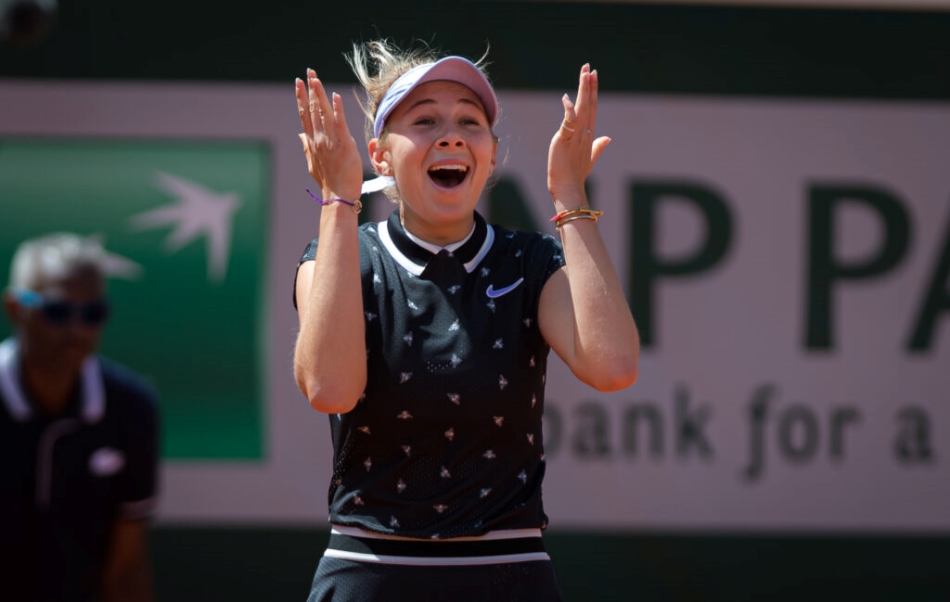
Roland Garros 4th Round: Thiem Marches on…
As a contributing article to Tennis with an Accent, I wrote a post-match report on Dominic Thiem’s victory over Gael Monfils, with commentary on Dominic Thiem’s kick serve, Gael Monfils’s persistent tactical weakness, and Thiem’s keys entering the quarterfinals at Roland Garros. Click on the link below:
Thiem Kicks a Stubborn Monfils
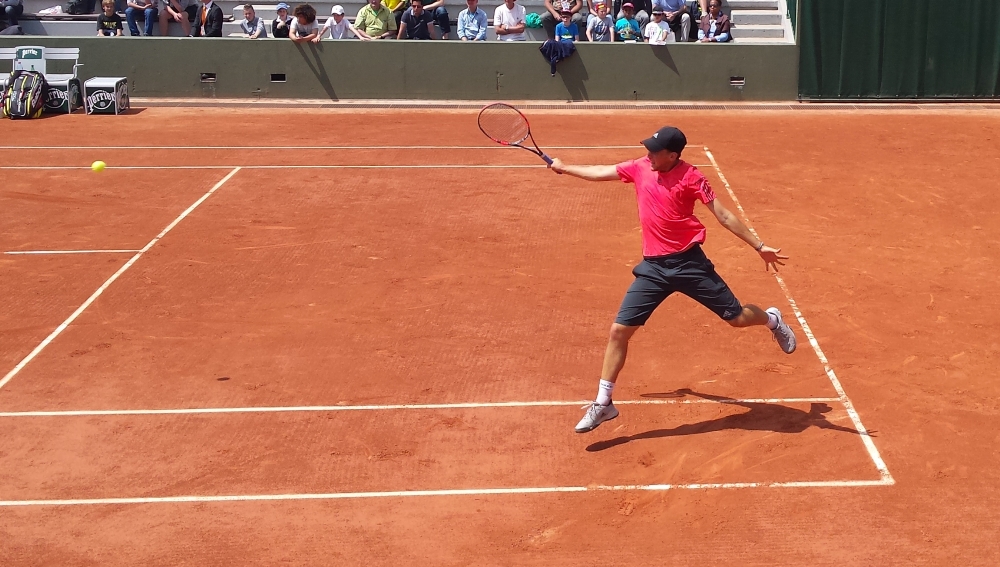
Jan-Lennard Struff Pulls Off an Improbable Victory
Improbable it was, and that is no exaggeration. Jan-Lennard Struff of Germany, in four hours and 22 minutes, defeated the 13th-seeded Borna Coric 4-6 6-1 4-6 7-6 11-9 after an encounter that could (should) have been over in the Croatian’s favor at a number of occasions throughout the last two sets.
There are few reasons why Struff’s win was exceptional. For starters, for a large portion of the encounter was played on Coric’s terms. It consisted of both men relying on their serves to win points or to create a 1-2-punch opportunity. Both fared well in that department throughout the match, except that when they engaged in rallies, Coric regularly kept coming out on top. Struff was the one who needed to take extra risks (not that his regular game is not risky to begin with) and when he did, there were periods of time when he turned erratic.
More importantly, when the fifth and deciding set arrived, for 14 games – until 7-7 – Struff’s first serve that was crucial to his chances of winning left Court 14 to take stroll around Paris. He fell behind a break twice and still recovered – more on this coming up below.
It should also not be taken lightly that the German’s opponent was on his favorite surface and not playing a bad match by any means.
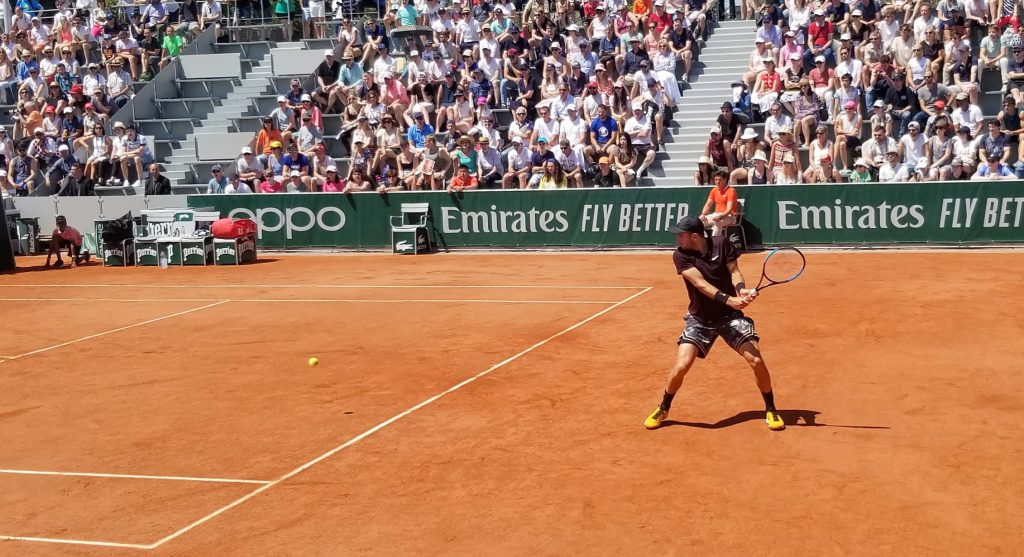
Let me go à priori through the first four sets which were something to behold on their own.
The first set is a good example of what I noted above, with both men using their first serves to create chances. They served a total of 5 aces combined but won a load of points on follow-up shots that put them in a winning position (or straight 1-2 punch winners). In fact, Coric’s first serves were so exceptional that he won 100% of his first-service points (which reminds everyone that you can perfectly dominate on your service without hitting a ton of aces, as long as you vary the pace, spin, and placement).
Coric also tried to step in on Struff’s second serves and pound returns (he positioned himself quite far back on Struff’s first serves, understandably – see photos below).
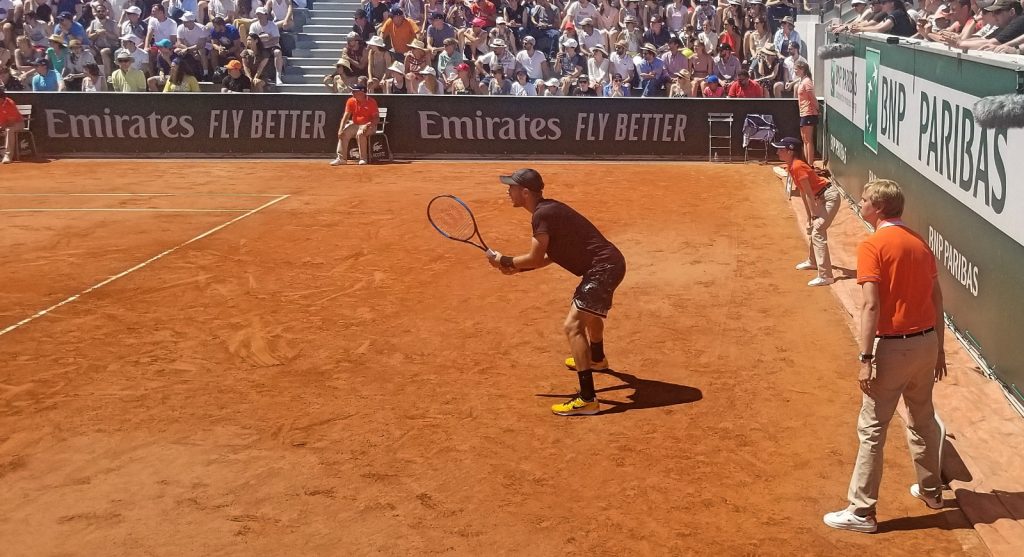
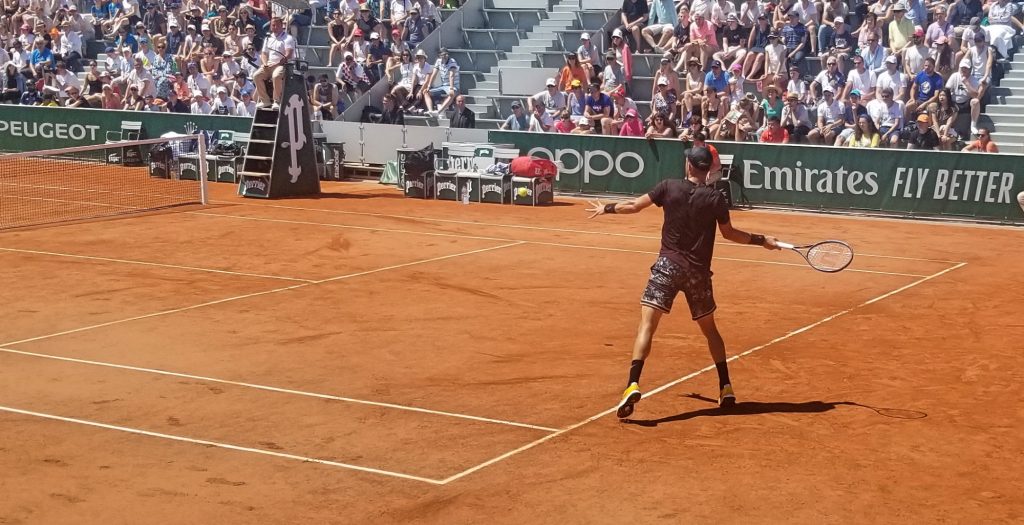
He made some of those aggressive returns, missed others. Struff, for his part, mixed in some serving-and-volleying or going to the net behind the 1-2 punch. Both players were putting their IQ’s to use, which was nice to see.
It was a clean, quality set of tennis, both playing clean tennis.
Coric did nonetheless seem to be one step closer to the finish line because whenever they engaged in rallies, he would come out on top. He also earned more opportunities to break his opponent’s serve (5 total break points) while Struff did not earn any.
Something needed to change, or the players were headed for a tiebreaker. The change happened at 4-4, on Struff’s serve. Coric got three excellent returns in early in the game and the score got to deuce. Few points later, on the third deuce, Coric was able to pin Struff to the baseline for another extended rally, ending with the German’s backhand unforced error. Coric capitalized on the break-point opportunity when he dipped his backhand low to the German’s feet at the net and forced him to miss. That is all Borna needed. He held serve, comfortably again, to confirm the break and take the first set 6-4.
Struff, knowing he now carries the burden of having to adjust, came out swinging in the second set. I mean, really swinging. Aiming for winners early in the rallies, nailing returns whenever he could, attacking the net behind approach shots struck to the corners, you name it, he tried it. And he did not miss! It may have been one of the best sets – or, the best – played by any player in the tournament so far. For all the risks that he took, Struff finished the set with one (yes, ONE) unforced error!**
**As usual, I do my own unforced-error count.
He also won 8 out of 10 points at the net and hit seven winners from groundies, averaging to one a game. He even won 10 out 16 points in rallies of 5 shots or more. If someone wonders what it means to “zone” in tennis, show them Struff’s second set in this match. It was a 32-minute-long blitz, and frankly, quite spectacular to watch.
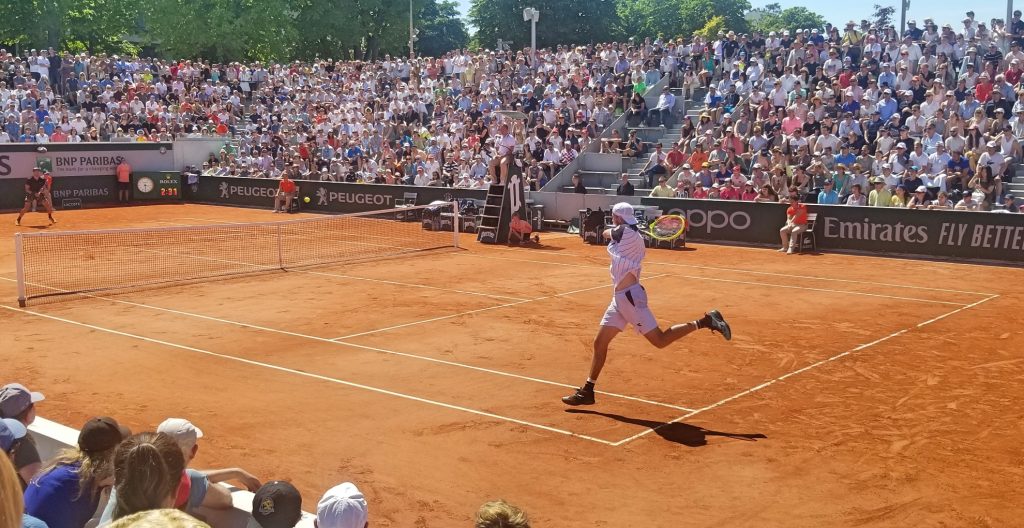
Coric, however, is not one to crumble. His mind is as anhcored as his game, and it takes a lot more than that to break his resolve. His ability to avoid drastic ups and downs in the mental department is one of the reasons for his steady rise through the ATP ranks (top 50 for two years, now top 20 for almost a year). He began by stopping the bleeding with an excellent game to start the third, hitting basically four service winners – including an ace. After Struff held his serve, Coric produced a second quality serving game, ending it with another ace.
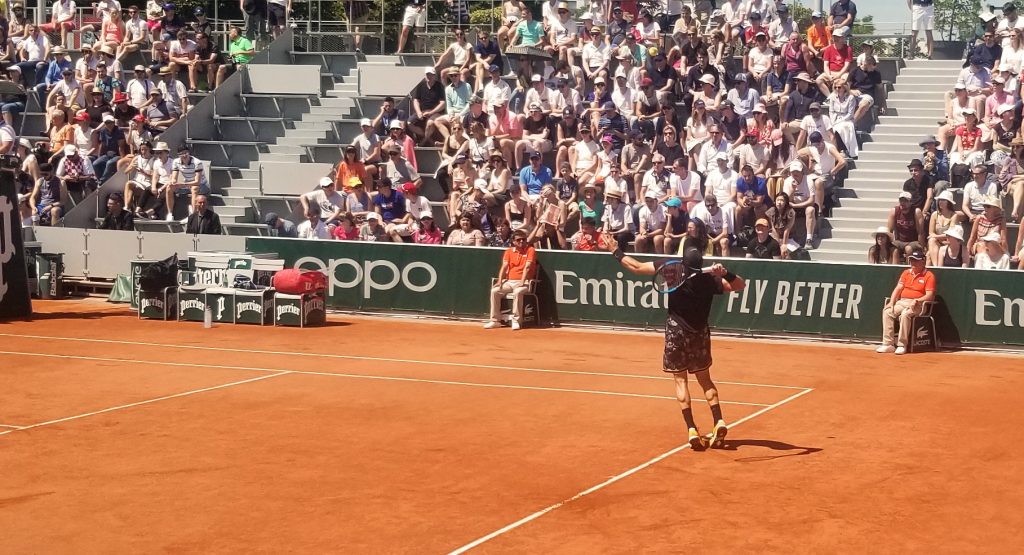
Just like that, the ship was steadied. Coric began to routinely win his serves again. Just like in the first set, he won 100% of points started with his first serve. Just like in the 4-4 game of the first set, Coric broke Struff’s serve at the end of the third set to close it out 6-4. In that 5-4 game, the only break of the set, Coric was once again able to engage Struff in a long rally that ended with the German’s error.
Struff did not respond to his third-set loss with the same surge as he did after losing the first set. In all fairness, how could he? His second-set output, nonpareil in every way, would be hard to match at any point in the near future. So, the fourth set unfolded very much in the same way as the first and third sets, with both men winning their serves, same patterns reemerging. Each man had to save one break point before we got to the late stages of the set.
Down 5-6, Struff had to hold to stay alive in the match and force a tiebreaker. He was within two points of losing the match on four occasions. In both of the last two of those, he had to resort to second serves. Coric, who has been going for his returns and having decent success at it until that moment, sailed the first return deep and nailed the second in the net (and yes, I count those as unforced errors, although official stats don’t just because it’s a return, but Coric was in no trouble at all, completely in position for both). Struff was fortunate to remain in the match after a game in which he committed a double fault and missed a routine forehand volley to the open court at deuce.
The tiebreaker was a blur, in a bad way for Coric, probably the worst 8-point stretch of the match for him until then. He made a couple of unforced errors, Struff hit an ace and winner, and he found himself down 0-6 in a flash. Two points later, he lost the set on a double fault.
Having played under pressure for most of the match, against an opponent was the better player overall for almost three hours (except the second set), and having survived second-serve points in order to avoid going down a match point twice, Struff must have felt fortunate to be at 2 sets a piece.
Did I mention that the sun was shining brightly, and that the temperature was rising? Probably the hottest day of the tournament so far.
Fifth set began much in the same way as the previous sets have – except the second, of course. Then came the 2-2 game…
Coric nailed four incredible returns in 6 points, one a clean winner, two that Struff could not get back, and one that he barely got back but that Coric drummed away on the next one. But man, oh man, how Coric would have loved to trade one of those returns for the two that he missed at 6-5, deuce, in the fourth set!
As if to mock Borna, at 30-30 in the next game, Struff nailed a return winner of his own to get to 30-40 and struck another one so hard and deep that Coric could not get back.
Breaks exchanged. Order restored!
Until the 6-6 game, that is…
Coric broke Struff’s serve again (more coming below about the German’s serving in the fifth) and had an opportunity to serve out the match at 7-6. But, he did not get a single first serve in and got blanked to lose the break advantage.
Speaking of not making first serves, here comes the most notable head-scratching stat of the day. Until 7-7, Struff made only 30% of his first serves. That is 14 out of 46 in numbers, folks. He fell behind a break twice during that period, and yet, he still found a way to survive.
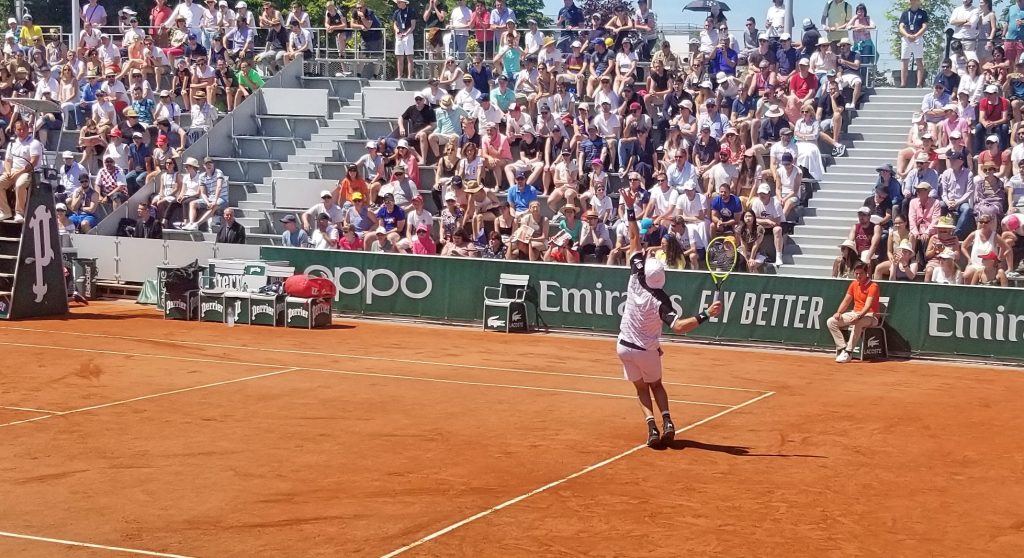
In the 5-5 game, for example, he lived solely on second serves and still held. Let me reiterate that Struff’s game plan and success largely depend on him getting the most out of his first serves. In other words, he survived under crippling circumstances from his perspective, for the large majority of the deciding set. He was clutch though! When he was down a break point twice in the 4-4 game, he knew to get in two big first serves (part of that 30% through the first 14 games of the fifth set) to save them. He knew how to pull the two big returns, as noted above, at 3-2 down, 30-30 on Coric’s serve.
Last but not the least, he did finally manage to turn his dismal first-serve outing until 7-7 into a banner one in his last three serving games, getting 16 out 22 first serves in. That is 73%, up a whopping 43% from the first 7 serving games of the final set. At 9-9, he served 5 out of 6 first serves in, three of them aces!
Coric, on the other side of the net, looked weary, mentally and physically. Down 9-10, he began the game with a forehand unforced error. He made only one first serves out of eight attempts in that game and double-faulted twice, the second one giving Struff a match point. The German sealed it with a winner, and the numerous Germans on Court 14 began the celebration chants while he collapsed on his knees, in a state of euphoria.
I used “improbable” in the title, only because this is the type of match whose details, for the most part, tell you one thing, yet the scoreboard says the opposite.
Did the winner outplay the loser? Not really. Did the loser choke? Not really, certainly not in the way that caused the match to take a 180-degree turn. Did the winner make an amazing turn-around? Not really, there were several dispersed occurrences, mostly in the fourth and fifth sets, that determined the final score.
Did one player get lucky, or the other unlucky? No.
Was the winner fortunate? Yes!
Did the winner deserve to win? Certainly!
And there lies the difference between “lucky” and “fortunate.”
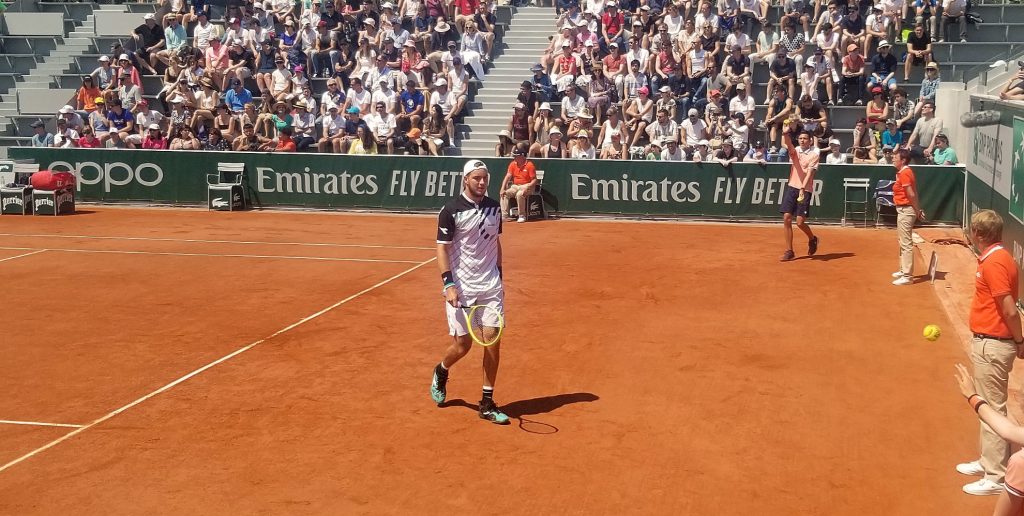
Anna Blinkova, Against All Odds
I am sure many French tennis fans left Philippe Chatrier stadium disappointed following the come-back win (1-6 6-4 6-4) by Anna Blinkova over Caroline Garcia because they felt that Caro had the match in her grasp only to let it slip away. We tend to exaggerate – and this is not necessarily a criticism – the importance of the last few games, or even the last few points of a match, and reach an overall conclusion based on that limited scope.
On the one hand, it is undeniable that Garcia squandered the lead in the third set, yes. Twice! It is also undeniable that Blinkova deserves some appreciation for her resolve in turning a hopeless situation into a balanced one by the end of the second set.
For fans of Anna, or those who have been following her rise over the last few years closely, the fact that she maintains a positive body language on the court, exuding confidence, and truly “looking the part” in doing so, will not come across as a news flash. I would venture to say that as a 20-year-old, she is as ironclad as tennis competitors come in the mental department. She is constantly tuned-in for the next point. “Now” seems to be the key word for her. That is the case whether the scoreboard shows her leading a set and 4-0, down a set and 0-4, or in the second game of the match.
…or, when she gets completely crushed in the first set (1-6) and begins the second set with a double fault… which was where she found herself on Thursday afternoon against Garcia.
How bad did she get dominated? Garcia blitzed to 3-0 lead, serving 9 out of 10 first serves in, hitting five winners. Blinkova barely got a glimmer of hope when she had a break point at 1-3 down. But Garcia shut that door on that quickly and resumed the one-sided affair until the end of the set. She finished with a flurry, hitting 20 out of her 26 first serves in (77%) which not only gave her free points on return errors but also kept setting her up for the next shot (again, 1-2 punch in effect).
Her game was sparkling clean, making a total of only four unforced errors in the first set, which is a stellar stat considering how much risk she takes on her returns and groundies.
For those who may not have noticed (although it is quite hard not to), Garcia indeed takes the ball extremely early on returns, and often does so continuously throughout the match. She has been doing this for a long time – for example, see my match report from 2014 on her qualifying match in Cincinnati –, it is one of the trademarks of her game. She has great hands so she can pull it off most of the time. Every now and then, as the saying “you live by the sword you die by the sword” goes, it works against her. The first set was a case of the former. She put so much pressure on Blinkova that the Russian would just whack the ball back herself, in an attempt to thwart further assault by Garcia’s penetrating strikes. Naturally, that led to several ‘forced’ errors on Blinkova’s part.
For an example, out of many, of how effective Garcia can be with those aggressive returns, see the 30-15 point in the first game of the second set. Garcia smacks a lunging forehand return flat and deep back to the baseline which sends Blinkova (who hit a fairly solid first serve half a second ago) stretching desperately to her ad side to get the ball back. She does, but it’s short. Garcia moves in and nails the backhand winner to the corner.
In case you want to observe both examples (in other words, examples of living and dying by the sword), fast forward to the 4-2 game in the third set to see three in a row. With Blinkova leading 40-0, Garcia hits two scorching return winners, one forehand one backhand, on two well-struck first serves by Blinkova to get to 40-30. Then, she goes for a third return-winner attempt on another first serve and misses it deep to lose the game. All three returns are hit from at least a meter inside the baseline (she even waits for them on or inside the baseline).
Let me get back to the match and put things into perspective at this point. Here we are, after a lop-sided first set that went Garcia’s way, and Blinkova just committed a double fault to start the second set. Garcia hops to her left and walks to return the next point, full of positive energy. It’s also worth, at this point, to remember the larger context of the match: Blinkova a young qualifier who entered the WTA top 100 only about eight months ago, had stepped on court Philippe Chatrier for the first time in her career to face a seeded French player.
And now back to the 1-6, 0-15 moment:
– Blinkova serves an ace to the ‘T’!
– It is one of her only two aces in the match, her only one in the second set. But it could not have come at a better come!
– She hops up twice (with energy) and pumps her left fist!
– She turns back with a swagger, says “come on,” and gets a ball from the ballkid on the deuce side.
– Then, she rotates to her right with her head up and gets another ball from the other ballkid.
– She struts right back to serve and hits another first serve (wins that point too, but that is not important for now)
The above sequence lasts around 10 seconds. It should be ten seconds that every coach should require their pupil to watch. Not the double fault, not the ace, but rather Blinkova’s body language between the two. A sequence that includes no actual tennis, but one that has everything to do with competitive tennis.
The coach should also ask the pupil, just for good measure, if the woman who just served looks like someone who served a double fault 30 seconds ago after getting pulverized 1-6 by a seeded opponent at a Major.
That’s Blinkova in a nutshell. What counts is “now,” where it counts is “the court.”
Later in that game at 40-30, Blinkova is able to float back deep another aggressive return by Garcia and manages to engage her in a rare rally. Garcia eventually makes the error (long rallies are not exactly her forté). Blinkova yells and makes a fist and pumps herself up further as she struts with even more confidence to change ends. In retrospect, that first game of the second set looms large as one of the turning points of the match.
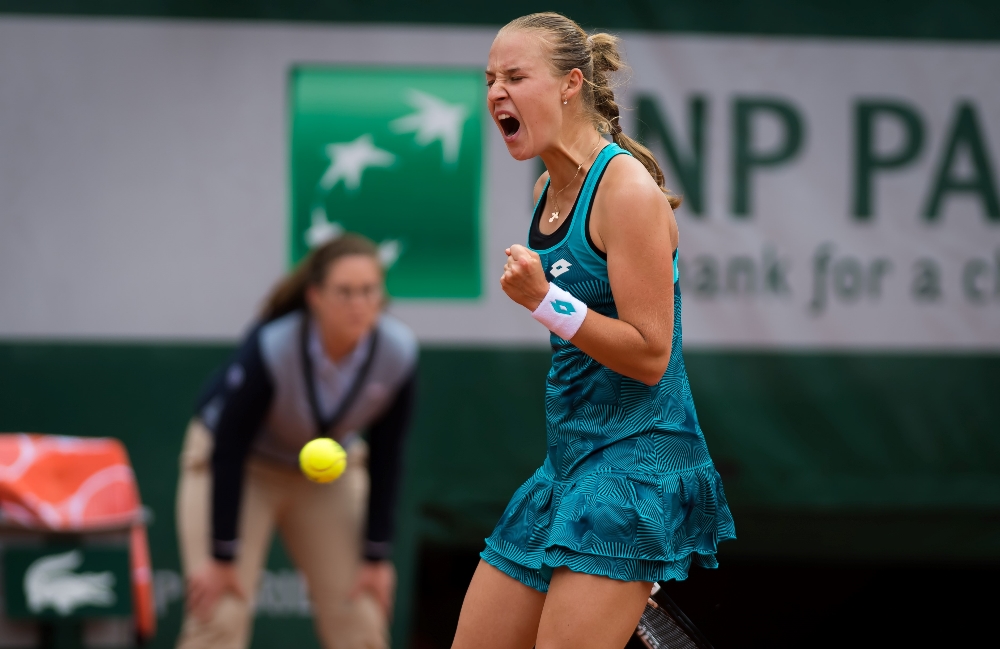
Garcia continues to go for her returns, Blinkova continues to scramble and fight, but the match is now more balanced. More importantly, Garcia has finally cooled down a tad. The biggest difference is on her first-serve percentage which drops down to 52% in the second set, down from 77% in the first. Less first serves results in more returns in by Blinkova, which in return means longer rallies. It is on one such point that Blinkova finally breaks through when she wins the 30-40 point at 4-3 and yells loudly “come oooon” with her fist pumped up high!
Although Garcia breaks back, Blinkova is still able to break right back in the ensuing game because Garcia, and this is where she has to shoulder the blame a bit, makes three backhand unforced errors in a row to go down 0-40, and loses on another backhand miss into the net (though this one was on a deep return by Blinkova) at 30-40.
The more important trend is that since early in the second set, the match has been played more on Blinkova’s terms, unlike in the first set.
Third set begins with yet another double fault by Blinkova (total of four for the match). But this time, there is no ace following it, instead a backhand unforced error that puts her down 0-30. When she double-faults again at 30-40, her second in the game, but fourth and last one for the match, Garcia goes up 1-0. It’s once again full speed ahead for the Caro train.
She goes up 3-0 in the blink of an eye, looking as invincible as she did in the first three games of the first set. She even gets a point to go up 4-0 at 40-30.
And it’s from this point forward that those claiming that Garcia squandered her lead have a point. Because on that point to go up 4-0, the Frenchwoman, who has been playing impeccable tennis since the final set began, makes her first unforced error of the set when she floats a backhand deep. Blinkova eventually breaks Garcia’s serve to get back 1-3.
Just like that, momentum changes, one thing leads to another, and Blinkova wins five out of the next six games to pull the upset. To add salt to the wound, Garcia wins only two points after 4-4, making four unforced errors and a double fault (on match point) on the way.
There is no need for a long conclusion paragraph for this one. It’s a career win for Blinkova and a devastating exit for Garcia. But neither those who give all the praises to Blinkova for this comeback, nor those who place all the blame on Garcia are correct. It’s a bit of both. Blinkova showed how wise (and cool-headed) she is beyond her years in the second set, and Garcia crumbled in the third after a fantastic start to grab an early lead. Ultimately, it was a three-set match that had one brilliant set for each, and one set that was at the same time memorable for one, and forgettable for the other.
Blinkova will face the winner of the Madison Keys vs Priscilla Hon match. It will be the Russian’s sixth match in 11 days, assuming it will be played on Saturday. I am fairly certain that will not matter to Blinkova. She will be tuned-in and ready.
Roland Garros Match Report: Del Potro vs Jarry (1st round)
My post-match analysis of Juan Martin Del Potro’s four-set victory over Nicolas Jarry is now available on Tennis with an Accent. Click on the link below to access the article and follow Tennis with an Accent throughout Roland Garros for up-to-date news and insightful write-ups.
